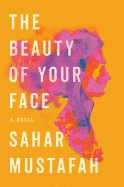
| Publisher: | Norton | |
| Genre: | Cultural Heritage, Family Life, General, Literary, Coming of Age, Fiction | |
| ISBN: | 9781324003380 | |
| Pub Date: | April 2020 | |
| Price: | $26.95 |
| Starred | Fiction |
by Sahar Mustafah
Sahar Mustafah's skillfully nuanced debut novel, The Beauty of Your Face, traces one family's challenges in adjusting to life in the United States through the perspective of first-generation Palestinian American Afaf Rahman. Readers first meet Afaf as a wife and mother and the principal of a private Muslim girls school in Tempest, Ill. At the close of the first chapter, Afaf, while praying downstairs in the school, hears gunshots above her.
Mustafah, maintaining a third-person narrative, then flashes back to 1976, when Afaf was 10 years old, and her 17-year-old sister, Nada, disappeared. The police pronounce Nada a runaway, and the tension simmering between her parents comes to a boiling point. Afaf enjoys her friendships, music and the limited independence her bike affords her, alongside her growing awareness of her mother's displeasure with American life. The author's interspersing of chapters from the shooter's perspective makes it impossible for readers to see him as pure villain. He was neglected by his parents and abandoned by his older sibling, just as Afaf was. A near tragedy drives teenage Afaf and her father into the Islamic Center, where they both begin to heal. In recounting the specifics of Afaf's journey of faith and self-discovery, Mustafah paints a universal picture of coming to understand oneself.
Afaf's incessant desire to win her mother's approval gives her empathy for her own children, her husband and her students. With exquisite pacing, Mustafah builds suspense and also Afaf's quiet courage until--in the book's final chapters--Afaf must do her hardest work yet. She must confront the shooter in order to save her students and herself. --Jennifer M. Brown, senior editor, Shelf Awareness

| Publisher: | Atria | |
| Genre: | Women, General, Literary, Fiction, Historical | |
| ISBN: | 9781982124106 | |
| Pub Date: | April 2020 | |
| Price: | $27 |
| Fiction |
by Megan Campisi
Megan Campisi's Sin Eater opens with a 14-year-old girl named May being arrested for stealing a loaf of bread, in an alternate version of Elizabethan England. The royal family of Angland is entangled in court intrigue and murders, including of babes, to secure favored heirs to the throne, even considering marriage to the hated Northern lords. Common people work hard for a meager living; some starve unless given permission from the queen to beg in the street. The penalties for petty crimes are high: vagrants have a hole "burned through the gristle of [the] ear with a hot iron as thick as a man's thumb." The penalty for a second offense is death.
In this cruel world, below even dung men and woad dyers in the social order, lies a cursed role: that of the Sin Eater. "It's always women who eat sins, since it was Eve who first ate a sin: the Forbidden Fruit." She is called to deathbeds to hear the Recitation, a confession of sins; she translates these sins into foods, which the family will prepare for the Eating. By taking the sins of others into herself, the Sin Eater absolves the deceased.
Sin Eater is a fully fleshed work of speculative fiction, abundant with the fine details of Elizabethan life and, of course, food. May is a damaged and sympathetic heroine, at once intelligent and innocent. This is an opulently imagined debut, horrific and weirdly beautiful, filled with earnest feeling as well as cruelty. Set aside time to read this engrossing novel in one go. --Julia Kastner, librarian and blogger at pagesofjulia

| Publisher: | Ecco | |
| Genre: | Women, Humorous, Family Life, General, Fiction | |
| ISBN: | 9780062909077 | |
| Pub Date: | March 2020 | |
| Price: | $26.99 |
| Fiction |
by Laura Zigman
When Judy Vogel attempts the "ruthless purging of possessions" recommended by a trendy book, she thinks, "I already feel invisible; why not go all the way?" A baby sling, received when 13-year-old Teddy was born, triggers melancholy over his current teenage moodiness. But maybe the sling can give her joy--if she can fill it with "something baby-like." So begins the wearing of Charlotte, the family's 20-pound sheltie. As the narrator of Separation Anxiety, the fifth novel by Laura Zigman (Animal Husbandry), Judy describes in hilarious detail Charlotte-as-accessory and her other attempts to assuage midlife angst.
Anxiety that her husband, Gary, sleeps in a basement bedroom because they can't afford to actually separate tops Judy's troubles. Defending the "warm cotton sack of dog fur" as her choice of "a harmless, nonalcoholic, nonnarcotic, noncannabinoid solution" to her stress is commendable, she muses. Judy's contract work for a website, plus Gary's gig stocking snacks for an office, doesn't keep pace with Teddy's Montessori school fees or Gary's medical cannabis needs (his anxiety is well-established). The Vogels' domestic strife is matched by ongoing drama at Teddy's school, setting the stage for what becomes a very funny yet poignant climax.
Underneath the acerbic snipping, Judy and Gary's mutual respect survives. They share a cerebral sense of humor, and despite the stated goal of divorce they join forces in touching moments--for Teddy and for their dying best friend. "It is a choice--to accept, to believe, to remain--and I am choosing all of it now," Judy thinks, in this often hilarious and thoughtfully candid novel of midlife. --Cheryl Krocker McKeon, former bookseller and freelance reviewer
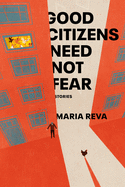
| Publisher: | Doubleday | |
| Genre: | Absurdist, General, Literary, Fiction, Historical | |
| ISBN: | 9780385545297 | |
| Pub Date: | March 2020 | |
| Price: | $25.95 |
| Fiction |
by Maria Reva
Ivansk Street, Number 1933, in Kirovka, Ukraine, seems be an exact address, but the town council's clerk insists "that building does not exist." Constructed last year, "someone seemed to have forgotten to connect it to the district furnace," but plenty of people already live there. These inhabitants comprise the memorable cast in Ukraine-born Maria Reva's skillful debut collection, Good Citizens Need Not Fear. The interconnected stories--inspired, remarkably, by her family's experiences--is a stupendous amalgam of pathos, black comedy and preposterous, post-USSR surreality.
Daniil, the building's no-heat messenger in "Novostroïka," is just one among 14 who inhabit his overcrowded unit. Zaya, an orphan with a cleft palate who gets discarded in "Little Rabbit," becomes a temporary 1933 Ivansk resident in "Miss USSR," then returns briefly in "Homecoming." A government agent sent to wrangle remorse from a famous poet in "Letter of Apology" ends up in the poet's employ guarding a saint's tomb in "Lucky Toss." Meanwhile, the poet's wife, Milena, sells illicit tunes etched into X-rays in "Bone Music," working with a neighbor whose near-empty abode will eventually receive one of Daniil's 13 roommates. Milena, too, switches units when she follows her heart in "The Ermine Coat," while an elderly couple living utterly alone in "Roach Brooch" inherits a Madagascar hissing cockroach that could prove invaluable--or not.
Nine entangled, intertwined, intricate stories later, Reva's fictional characters domiciled in a nonexistent building might seem absurd, but her remarkably convincing narratives assure plenty of thoughtful entertainment. --Terry Hong, Smithsonian BookDragon
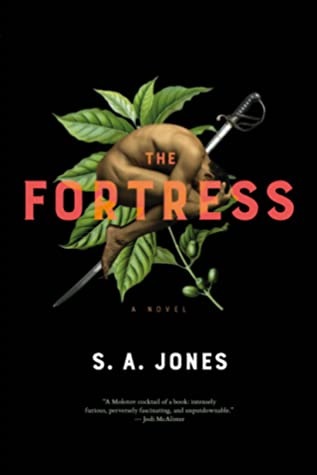
| Publisher: | Erewhon Books | |
| Genre: | Women, Dystopian, Dark Fantasy, Fantasy, General, Literary, Political, Fiction, Science Fiction | |
| ISBN: | 9781645660026 | |
| Pub Date: | March 2020 | |
| Price: | $16.95 |
| Fiction |
by S.A. Jones
To save his marriage, an egotistical lawyer must become a sexual supplicant in a female-dominated society in the intense psychological novel The Fortress by S.A. Jones.
Jonathon Bridge has a corner office, a bevy of female interns at his sexual disposal and is the envy of his coworkers. He loves his wife, Adalia, but abuses the interns because he can. Adalia is an investigative reporter and nobody's fool. She confronts Jonathon over his indiscretions and kicks him out.
Jonathon vows to do anything to reconcile. Adalia will take him back only if he becomes a supplicant to an all-female race called the Vaik. The Vaik live in an enclosed society but have a symbiotic relationship with the nearby New York City-esque metropolis where Jonathon and Adalia reside. The city's males sign up for selective servitude, so the Vaik can procreate, and in return the Vaik provide the city with healing creams, potions and foods. A supplicant must do whatever the Vaik command, without question; if he disobeys, he will be chained to a post at low tide. He will either drown or be eaten by sharks when tide comes in. Can an alpha male from a male-dominated world enter a female-run society and give in to complete submission?
The novel is part fantasy, part reality and all masterpiece. Jones immerses readers so completely in the fictious world of The Fortress that it's hard to believe the Vaik aren't real. And startling to realize how much a society could benefit from the Vaik. --Paul Dinh-McCrillis, freelance reviewer

| Publisher: | Grand Central | |
| Genre: | Private Investigators, Mystery & Detective, Domestic, Crime, General, Suspense, Thrillers, Fiction | |
| ISBN: | 9781538748145 | |
| Pub Date: | March 2020 | |
| Price: | $29 |
| Starred | Mystery & Thriller |
by Harlan Coben
Harlan Coben (Run Away) delivers yet again with The Boy from the Woods, a sweeping thriller of teen bullying, attorney-client privilege and secrets of the rich and powerful.
High-powered attorney Hester Crimstein gets a sudden visit from her grandson Matthew. He begs her to help find his missing classmate, Naomi, who was being bullied by rich and popular student Crash Maynard. Hester enlists Wilde--the titular boy now grown up and working as a private investigator--to find Naomi. Wilde quickly finds Naomi and discovers her "disappearance" was part of an elaborate prank by Crash and his friends.
They had convinced Naomi to go missing in exchange for the bullying to stop. She goes back to school, but the bullying intensifies. A distraught Naomi disappears again. No one takes it seriously except Wilde, a former outsider himself. This time, he can't find her. Wilde rushes to confront Crash, but Crash has gone missing as well; his parents, Dash and Delia Maynard, receive a ransom note. The wealthy Maynards think they are being targeted for their politics. They demand Hester and Wilde find their son before he's harmed. Wilde agrees to help because he thinks Crash's and Naomi's disappearances are connected. But will he be able to save both kids?
Fans of Coben's Myron Bolitar novels will recognize Hester Crimstein from her brief, applaud-worthy appearances. In this standalone, the author shows a softer Hester by explaining the bluster behind this formidable, no-nonsense attorney. In creating the role of Wilde, Coben introduces a reclusive and complicated hero extremely adept at solving mysteries--except for how and why he became "the boy from the woods." --Paul Dinh-McCrillis, freelance reviewer

| Publisher: | Harper | |
| Genre: | Fantasy, Contemporary, Suspense, Thrillers, Fiction, Action & Adventure, Science Fiction, Technological | |
| ISBN: | 9780062854674 | |
| Pub Date: | March 2020 | |
| Price: | $27.99 |
| Mystery & Thriller |
by Matt Ruff
One of the most playful of novelists, the inveterate genre-hopper Matt Ruff (The Mirage; Bad Monkeys; Set This House in Order) follows up the chipper, revisionist cosmic horror of Lovecraft Country with an online techno-thriller whose plot hook gets roasted by one of its own pop-savvy gamers as "Ready Player One meets The King and I." But this brashly inventive story can't be broken down to formula.
After establishing a crackerjack set-up--a down-on-his-luck guide to the online role-playing games of the near future takes a contract to "sherpa" a mysterious plutocrat through the world of MMORPGs, drawing the ire of the CIA--88 Names proves predictably unpredictable, especially as the author seizes every chance to toy with the conventions and possibilities of computer role-playing. The digital espionage at times seems like a formal excuse for Ruff's loving parodies of gamer trolls, dungeon crawls, Grand Theft Auto-like crime sprees and old-school Infocom text adventures, all rendered in the breezy, geek-positive, charmingly profane mode he established in his 1988 debut, The Fool on the Hill. But Ruff is clever enough to make 88 Names' many apparent detours crucial to the revelations of his final chapters.
While he's sufficiently steeped in the milieu of gamers to satirize, Ruff also persuasively celebrates the pastime of adopting a fictional persona to embark on monster-stomping quests. Unlike most stories involving VR, all-powerful corporations and the possibility of catfishing, 88 Names never verges into the cynical or dystopian. Instead, Ruff invites readers to play. --Alan Scherstuhl, freelance writer and editor

| Publisher: | Houghton Mifflin Harcourt | |
| Genre: | Biography & Autobiography, Editors, Journalists, Publishers, American, Personal Memoirs, General, Journalism, Literary Collections, Language Arts & Disciplines, Essays | |
| ISBN: | 9780358206682 | |
| Pub Date: | April 2020 | |
| Price: | $28 |
| Biography & Memoir |
by Jill Rooney Carr, editor
In 2008's The Night of the Gun, David Carr wrote about how, as a single dad battling drug addiction, he raised his baby twins in his home state of Minnesota. Final Draft: The Collected Work of David Carr inspires no less admiration for the journalist, who died in 2015 at age 58.
Edited by Carr's widow, Jill Rooney Carr, Final Draft gathers nearly 60 personal and journalistic pieces dating from 1989 to 2015; they're bundled into seven sections reflecting what Carr was up to when he wrote them: freelancing, working for Washington City Paper, columnist for the New York Times, and so on. One constant feature is Carr's signature folksy-wry wordsmithery--e.g., "I have friends in town from a place where the Beltway is found only on a pair of pants."
It's clear from the pieces selected for Final Draft that one of Carr's preoccupations was journalistic ethics, including his own: he cops to having blown it when he interviewed Bill Cosby in 2011 and didn't ask about the sexual assault allegations against him. Another obvious fascination of Carr's was people in the market for second chances; his profile subjects include a disgraced airline pilot, the plagiarist Ruth Shalit, and the formerly drug-abusing actor Robert Downey Jr. If there's a cautionary tale within Final Draft, it's not so much about the dangers of substance abuse as about the danger of giving up on someone--after all, that someone could have been David Carr. --Nell Beram, author and freelance writer
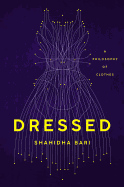
| Publisher: | Basic Books | |
| Genre: | Women, Industries, Fashion & Textile Industry, Art, Textile & Costume, Criticism & Theory, Fashion & Accessories, Health & Fitness, History, Design, Beauty & Grooming, Business & Economics, General, Aesthetics, Philosophy | |
| ISBN: | 9781541645981 | |
| Pub Date: | March 2020 | |
| Price: | $30 |
| Philosophy |
by Shahidha Bari
Dressed: A Philosophy of Clothes is a book for which a reader's knowledge of fashion is neither necessary nor especially useful. Being well versed in literature, film and art, on the other hand, will come in handy.
"If, like me, you are haunted by clothes... then you will understand something of the mystery and allure that this book sets out to investigate," writes Shahidha Bari in her introduction to Dressed. For Bari, who frequently makes references to Freud, a cigar case is never just a cigar case. Organizing her inquiry into five themed chapters ("Furs, Feathers, and Skins," "Pockets, Purses, and Suitcases," etc.), she dissects dozens of clothing items and accessories, many iconic (such as the dress in John Singer Sargent's Portrait of Madame X). Absolutely fascinating is her look at how the expanding size of women's handbags over time and the gradual inclusion of pockets in women's clothing correspond with increased female independence.
A professor at the London College of Fashion, Bari is an unflinching feminist ("How tiresome is the notion that a woman's shoes could be shorthand for her sexual availability") and an unflaggingly resourceful writer. Although Dressed is a dense text (it doesn't have that subtitle for nothing), respite comes regularly via the first-person meditations that begin each chapter as well as via the book's 30-odd photos and reproductions. A reader can compare, say, suits worn by Cary Grant in Alfred Hitchcock's North by Northwest and by the singer Janelle Monáe; under Bari's tutelage, the reader will see radically different garments. --Nell Beram, author and freelance writer
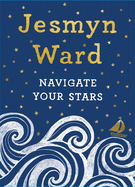
| Publisher: | Scribner | |
| Genre: | Self-Help, Personal Growth, Happiness, Success, Self-Esteem | |
| ISBN: | 9781982131326 | |
| Pub Date: | April 2020 | |
| Price: | $16 |
| Psychology & Self-Help |
by Jesmyn Ward, illust. by Gina Triplett
"Take a step that will lead you toward the realization of your dream, and then take another, and another, and another." So beats the heart of Jesmyn Ward's Navigate Your Stars, in which Ward (Salvage the Bones; Sing, Unburied, Sing; Men We Reaped) delivers a powerful message of endurance and empathy in this illustrated adaptation of her 2018 commencement address at Tulane University.
Ward's own persistence has yielded an extensive catalogue of accolades--including two National Book Awards and a MacArthur fellowship. But in Navigate Your Stars, humility abounds. "Good morning, y'all," Ward begins. "I want to tell you a story." What follows is Ward's poignant account of her journey to becoming a writer, layered across her developing sense of what success can look like.
Growing up poor in Mississippi, Ward felt education was her ticket to a better life. Ultimately, her own understanding of what "education" might mean also had to evolve: "I realized that education wasn't one choice; instead, it was a lifetime's undertaking." Tracing her growing awareness of the dictates of circumstance, she contrasts her experiences in education with those of her family--especially those whose choices, and horizons, differed from her own, and persisted nonetheless.
Gina Triplett's vibrant illustrations are awash in color, a resplendent canvas for Ward's tribute to hard work, determination and family. Ward's tender truths will resonate not only with graduates of all backgrounds, but anyone yearning for a message of hope and of promise--who will take a step. Then another. --Katie Weed, freelance writer and reviewer
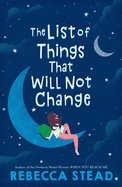
| Publisher: | Wendy Lamb/Random House | |
| Genre: | Family, Marriage & Divorce, Juvenile Fiction, LGBT, Siblings | |
| ISBN: | 9781101938096 | |
| Pub Date: | April 2020 | |
| Price: | $16.99 |
| Starred | Children's & Young Adult |
by Rebecca Stead
Newbery Award-winning author Rebecca Stead has a gift for inhabiting the minds and hearts of young readers. In The List of Things that Will Not Change, she explores the messy feelings that come with divorce from the perspective of a daughter who bubbles over with love, rage, anxiety, shame and hopeful anticipation.
Bea is eight and already a bit of a worrier when her parents announce that they're getting a divorce because her dad is gay. They give her a notebook with the start of a list they call "Things That Will Not Change." Here they state certain unchanging facts: They will always love her. They still love each other, "but in a different way." And she will always have a home with each of them. Although she is reassured by the fixed new routines of the shared custody, Bea's anxiety gets worse, complicated by a developing problem with anger management. This is also the year she begins seeing a therapist, who explains that there are often "feelings behind feelings"--fear behind dislike, for example. And, behind fear, worry.
Stead (When You Reach Me; Goodbye Stranger; Liar & Spy) understands that the kinds of things a child worries about can be unexpectedly different from what an older person might fear: after the divorce, for example, Bea wants to know where her cat will stay. Bea's narrative, in Stead's hands, is droll, poignant and always realistic, whether she's angst-ridden about the fifth-grade colonial breakfast project or trying not to scratch her eczema. Stead masterfully explores the internal life of a girl going through both extraordinary and run-of-the-mill trials in a way that tells readers they are not alone in their complicated, contradictory feelings about the world. --Emilie Coulter, freelance writer and editor
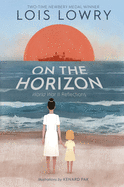
| Publisher: | Houghton Mifflin Harcourt | |
| Genre: | Biography & Autobiography, Asia, General, Military & Wars, Poetry, United States - 20th Century, History, Juvenile Nonfiction, Historical | |
| ISBN: | 9780358129400 | |
| Pub Date: | April 2020 | |
| Price: | $16.99 |
| Children's & Young Adult |
by Lois Lowry, illust. by Kenard Pak
Lois Lowry, author of The Giver, gives poetic glimpses into the lives of World War II survivors and victims in the slim yet powerful On the Horizon.
Lowry's author's note explains the inspiration behind the book: "When I was a child... it was always a treat when we could talk Daddy into setting up the projector and screen and showing the home movies." In one film, child Lois plays on a beach in Waikiki. As an adult, when she showed this movie to friends, one said, "Wait... Look on the horizon. That's the Arizona." In the moment captured on film, the USS Arizona "carried 1,200 men. Almost all of them would soon be dead."
The specific people whom Lowry has chosen to feature in this history in verse--Pearl Harbor sailors and Hiroshima civilians--have an arbitrary quality to them. This haphazard nature and the sparseness of the piece somehow work to magnify the book's purpose. Lowry's inspiration comes from a point in time that seemed like any other; every person highlighted in the work is living an ordinary day before the planes appear, before the bombs drop. It's all brief, senseless chance. Kenard Pak's illustrations enhance Lowry's theme; his gray-scale pencil art has an ephemeral nature that suggests any piece could be erased from the page. The illustrations, whether a person, a watch face or the tricycle buried alongside its child owner, are detailed yet have indistinct borders with edges that blend into the white of the page. Solemn and forceful, On the Horizon displays, with respect and love, the impact a seemingly ordinary moment can hold. --Siân Gaetano, children's and YA editor, Shelf Awareness

| Publisher: | little bee books | |
| Genre: | Emotions & Feelings, People & Places, United States - Asian American, Family, Social Themes, Juvenile Fiction, Multigenerational | |
| ISBN: | 9781499808865 | |
| Pub Date: | April 2020 | |
| Price: | $17.99 |
| Children's & Young Adult |
by Katrina Moore, illust. by Xindi Yan
Despite Daisy's carefully prepared "Things to do with Yeh-yeh" list, her goal during the week of her grandfather's visit is something far more challenging: "I have to make him smile before he leaves!" In creating Daisy and her Grandpa Grumps, Katrina Moore (One Hug) explores multi-generational, multicultural expectations and surprises with humor, patience and love, while Pratt-trained artist Xindi Yan's utterly delightful art adds cultural authenticity.
A tea party, hot cocoa and snowman-building are some of the activities Daisy plans to share with Yeh-Yeh (Dad's Dad), but his Sunday arrival is marked with grumbles rather than hugs. "Day and night, Daisy tried to make Yeh-Yeh smile, and day and night--he didn't." By Friday, a worried Daisy asks her mother for advice. "He shows love in other ways," she assures Daisy. Indeed, when Daisy sneaks into Yeh-Yeh's room with her latest surprise, she discovers plenty of evidence of his appreciative affection. By visit's end, there are belly laughs, jolly hugs and the promise of more time together.
Moore declares in her author bio that her mission is "to create books that children will hug for ages." Chinese-born Yan (Sylvia Rose and the Cherry Tree) helps fulfill this mission by augmenting the text with rambunctious energy. Pig-tailed Daisy and bushy-browed Yeh-Yeh's memorable expressions illuminate every page, and Daisy's sassy kitty and enchanting wardrobe (unicorn horn headband, fluffy boas and sparkling tiaras she shares with Yeh-Yeh) make for picture perfect scenarios. Her culturally sensitive enhancements are especially notable: the upside down fú character to welcome Yeh-Yeh's fortuitous visit; Chinese furniture and accessories throughout; and Chinese cooking tools scattered on kitchen counters. With Yan's Pixar-ready illustrations and Moore's sweet text about familial communication, Grandpa Grumps invites smiles all around. --Terry Hong, Smithsonian BookDragon